You may want to concentrate your bird banding efforts on your adult Tree Swallows, since banded adults are more likely than nestlings to return in future years.
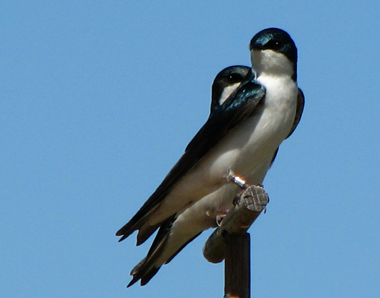
How can banders capture adults for bird banding?
Here’s one easy way we learned years ago when we were banding adult Tree Swallows at the Long Point Bird Observatory‘s Tree Swallow Research Project in Ontario, Canada. It utilizes a simple home-made trap that fits temporarily inside a box.
- The trap consists of a stiff plastic flap 3″ x 3.5″, with a long notch cut out lengthwise (below left).
- The other end of the flap fastens inside the box just above the entrance with masking tape hinges (below center).
- A stiff weed stem, set at an angle, props up the free end of the flap out of sight.
- Entering birds dislodge the prop stem and the trap swings down over the entrance, blocking it (below right).
- The bander returns and extracts the swallow for banding and processing.
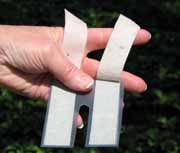
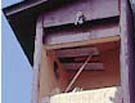
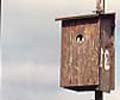
This method of box-trapping may be unfamiliar to some banders, so you may need to show your bander how. Below, an adult swallow, still carrying a damselfly for its young in its mouth, peers out through the trap.
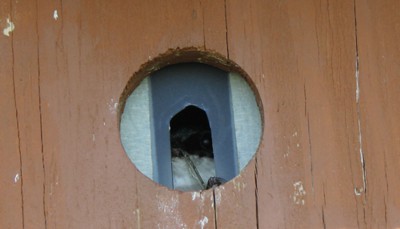
What’s the best time for trapping and banding adult Tree Swallows?
There is a specific window when it’s ok to trap and band adults: between 1 and 10 days after hatching. Your bander must resist the temptation to trap and band outside this window.
Be aware that even though nests at a project may be fairly synchronized, some nests will be ahead or behind the optimum time for banding. If your bander can’t make more than one trip to your project, you must leave the out-of-synch birds unbanded.
Doesn’t banding upset the adult Tree Swallows?
Adult Tree Swallows aren’t thrilled at being trapped, handled and banded, but their attachment to their young is so strong they almost never desert. But see warnings!
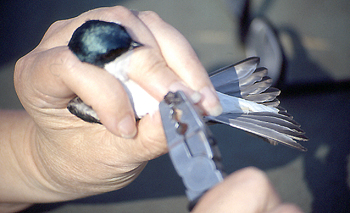
Warning! It is risky to trap and band adults before their eggs have hatched. This is because there is more danger of nest desertion during laying and incubation.
Warning! Never trap and band adults at boxes containing nestlings older than 12 days. The disturbance could cause nestlings to jump out of the box before they can fly well. Since grounded young aren’t usually fed by parents, they will die. To determine if nestlings are older than 12 days please see Banding Nestling Tree Swallows.
Warning! REMOVE ALL TRAPS AFTER USE! Both adults and nestlings can die if traps that are left forgotten in a box block entrances and exits.
Which are harder to trap, males or females?
Male Tree Swallows seem more cautious than females. However, most males can be trapped eventually when they enter to feed their young.
Here’s a hint for banders:
When you catch the female of a pair first, it’s best to keep her in a bird bag (out of the sun!) after banding and processing so she won’t alarm the male. Females can usually be held this way for up to an hour unless the temperature is too hot. Then, as soon as the male is trapped, the female should be released.
Males caught first can be released immediately after banding and processing, since their alarm behavior seldom stops females from entering boxes to feed young.
What does it mean to “process” a bird?
“Processing” is the taking of certain data by banders after they have affixed the band on a bird. Banders will record the date and location, and will determine the bird’s age and sex as closely as possible. They usually also measure some combination of weight, wing chord (see below), tail length, tarsus (part of the leg) length, and bill. Your bander will have sheets to record this data.
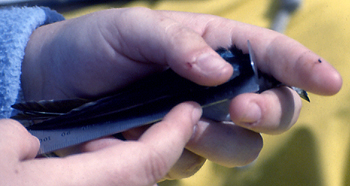
What do banders do with the data they take?
Banders submit all required documentation to the Bird Banding offices in either the Department of Environment and Climate Change Canada or the United States Geological Survey’s Bird Banding Lab. The data becomes computerized and available for use by other banders and researchers.
Can you keep your own records of data from banding adult Tree Swallows?
You will certainly want to keep your own banding records using data the bander gives you. You can use our Adult Banding and Recapture Record if you want. It has fields for the following information:
- Box number where the bird was captured.
- B/R: B if it is receiving a band, or R if it is a recapture of a previously banded bird.
- Band Number.
- Age, by plumage color.
- Sex, determined by brood patch (BP) for females, or cloacal protuberance (CP) for males.
- Color (blue, or brown).
- Wing Chord (a measure of wing length).Weight (mass in grams).
- Weight (mass in grams).
Your bander can show you how he or she takes measurements, and can also give you good looks at BP’s and CP’s. You can also refer to our page Sexing and Aging Tree Swallows for determining age, sex and color classification.
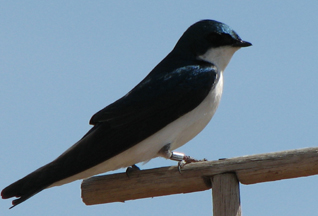
——————————————————————————————
Home: Tree Swallow Nest Box Projects
Creating Tree Swallow Nest Box Projects
Spring Return
Nesting Season Behavior
Song and Calls
Nest Site Claiming
Pair Formation
Nest Building
Bird Flight
Mating and Paternity
Diary of One Season at Salmon Creek
Monitoring Nest Boxes and Keeping Records
Making Box Checks Keeping Box Records Control Sheets Season Summaries Print Sheets
Banding Your Tree Swallows Banding Adults Banding Nestlings
Tree Swallows in Research Research Bibliography Glossary of Terms